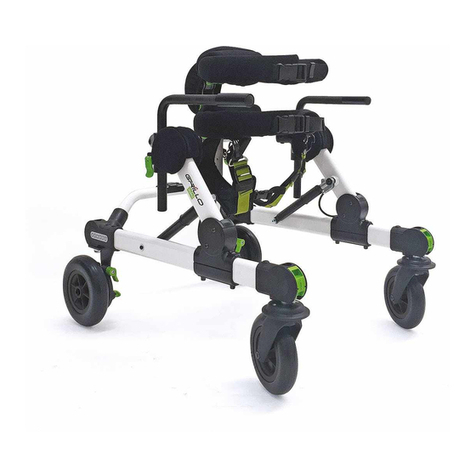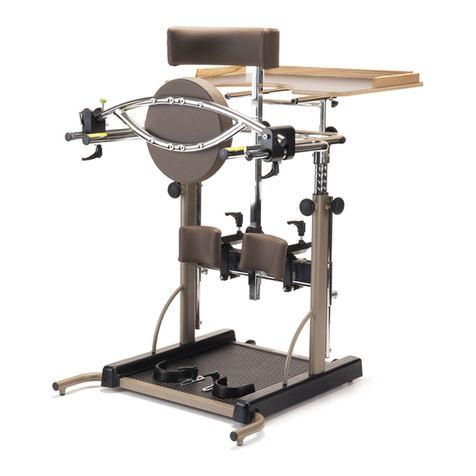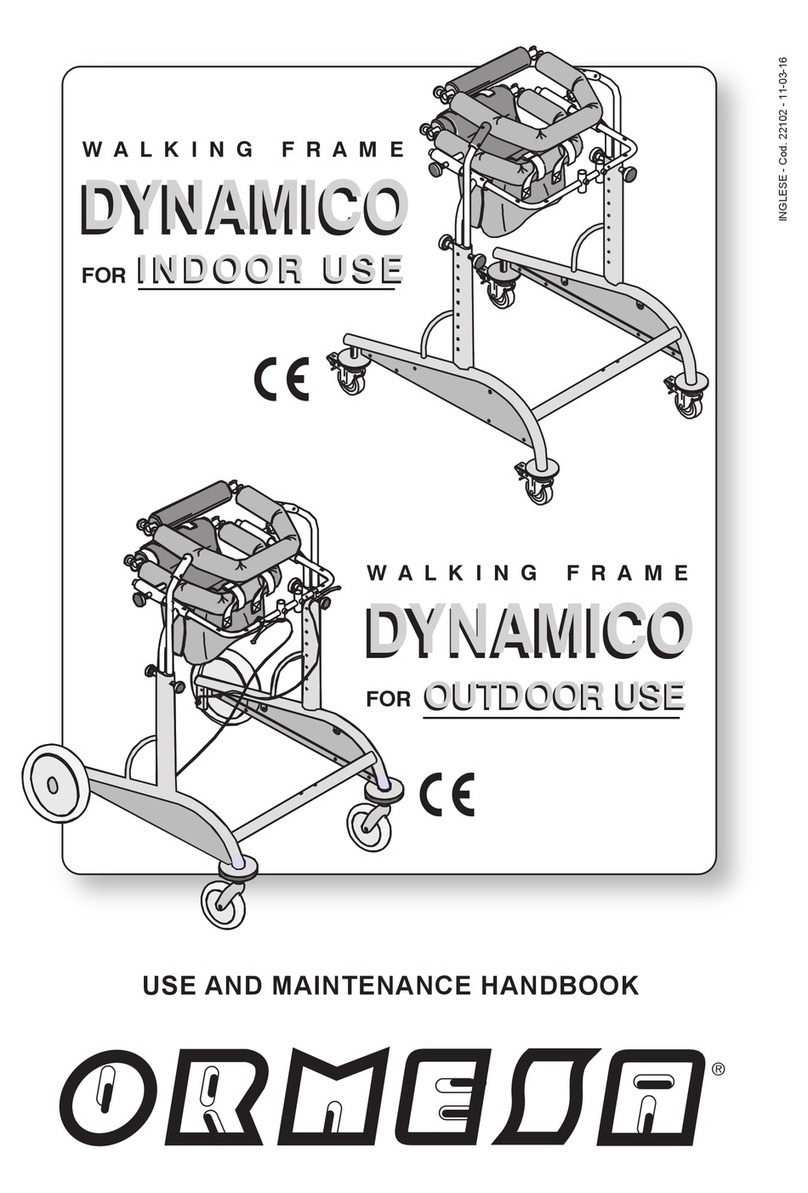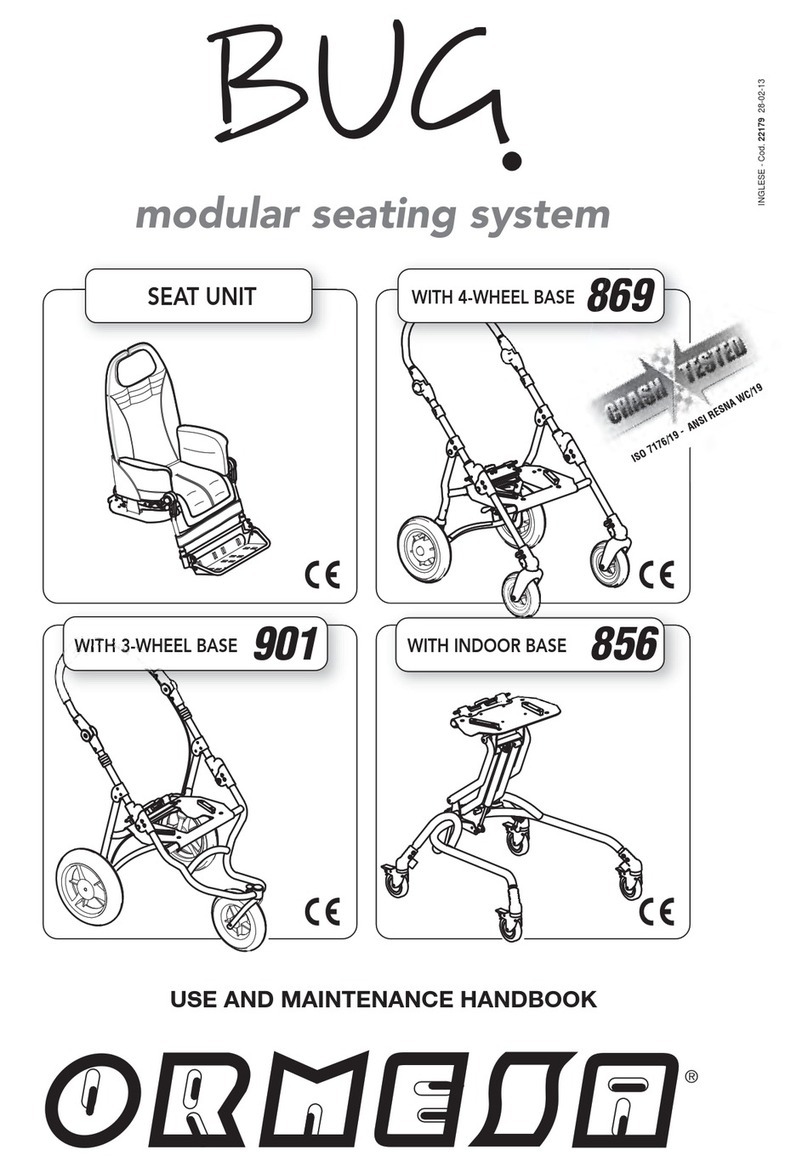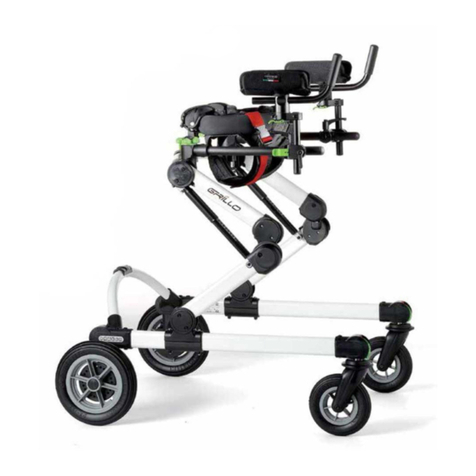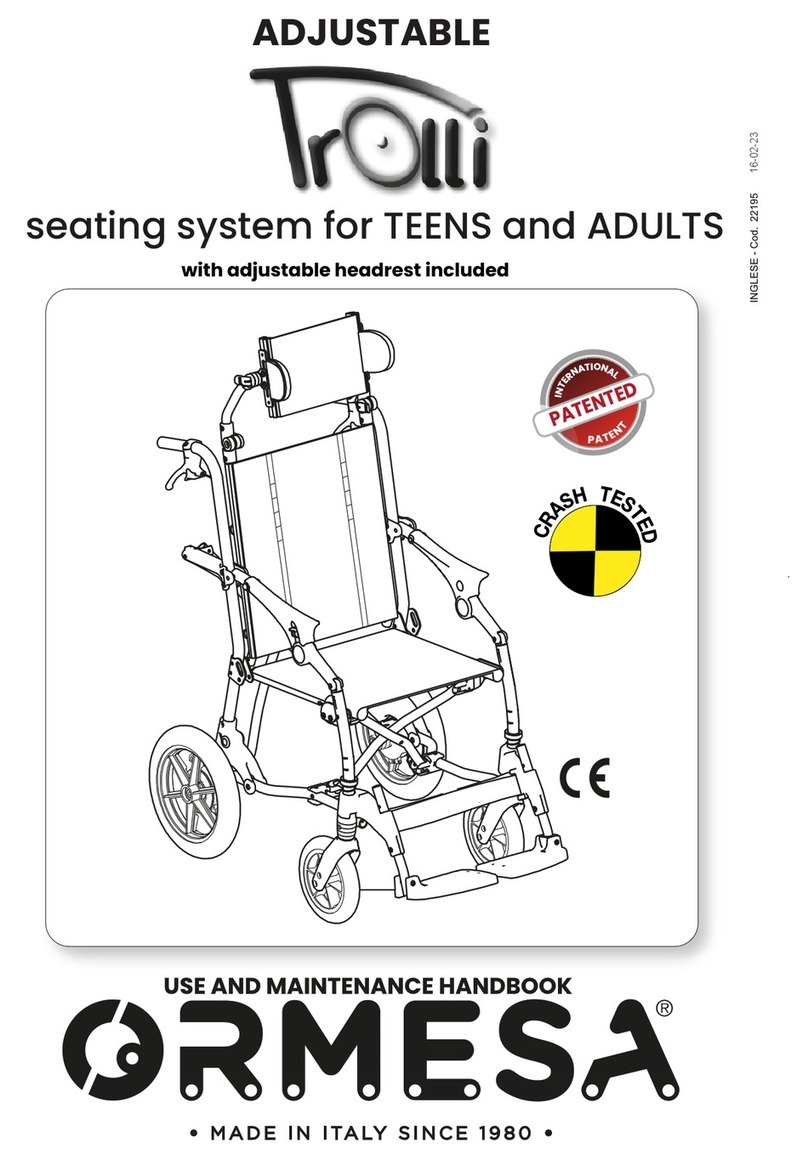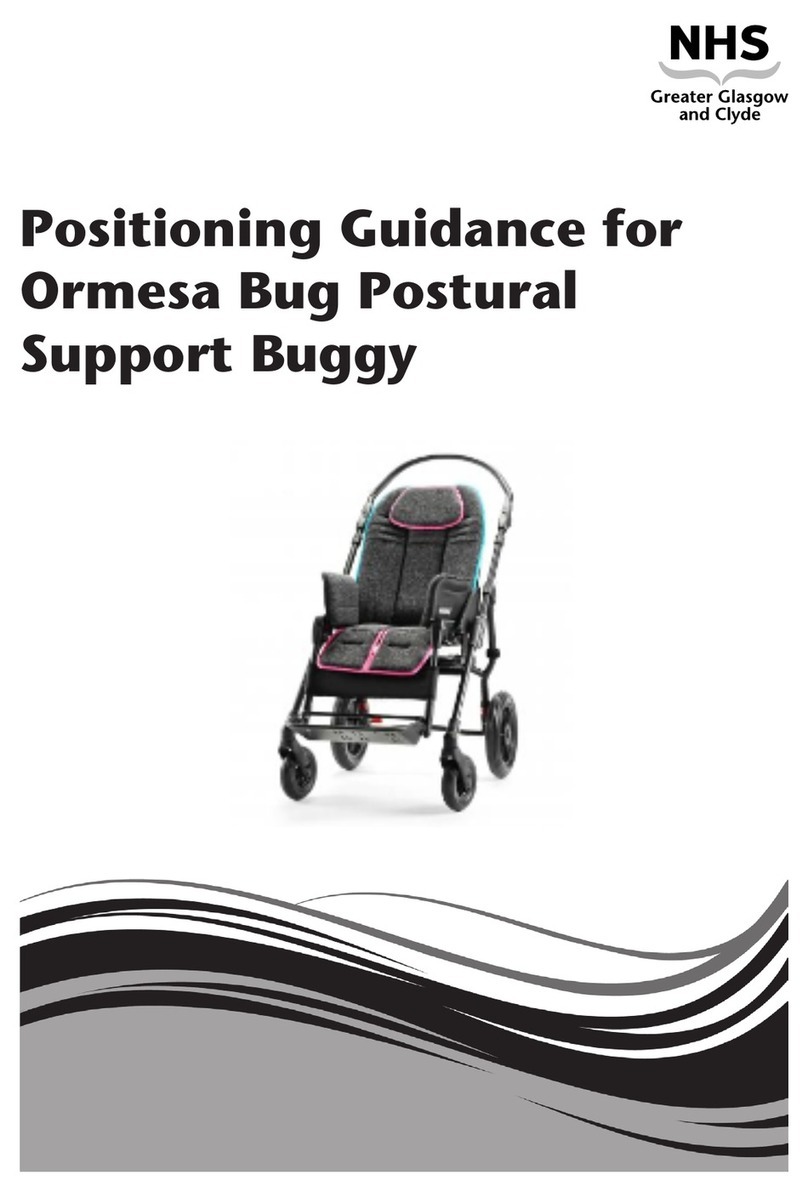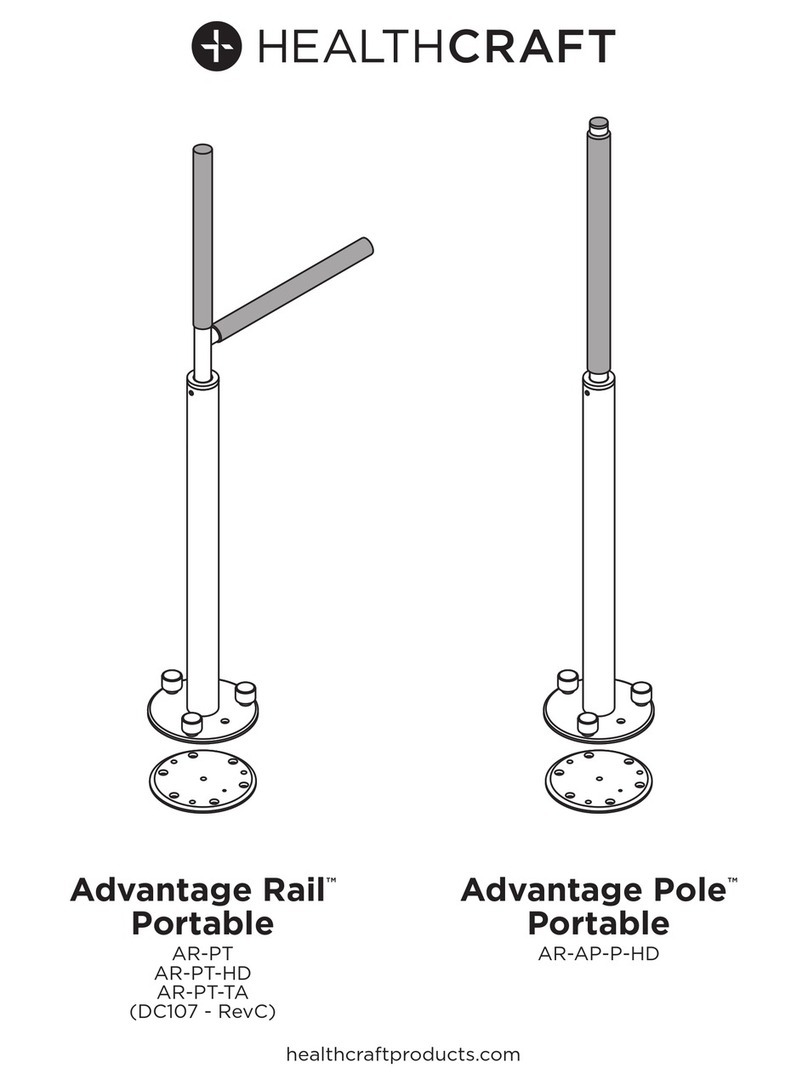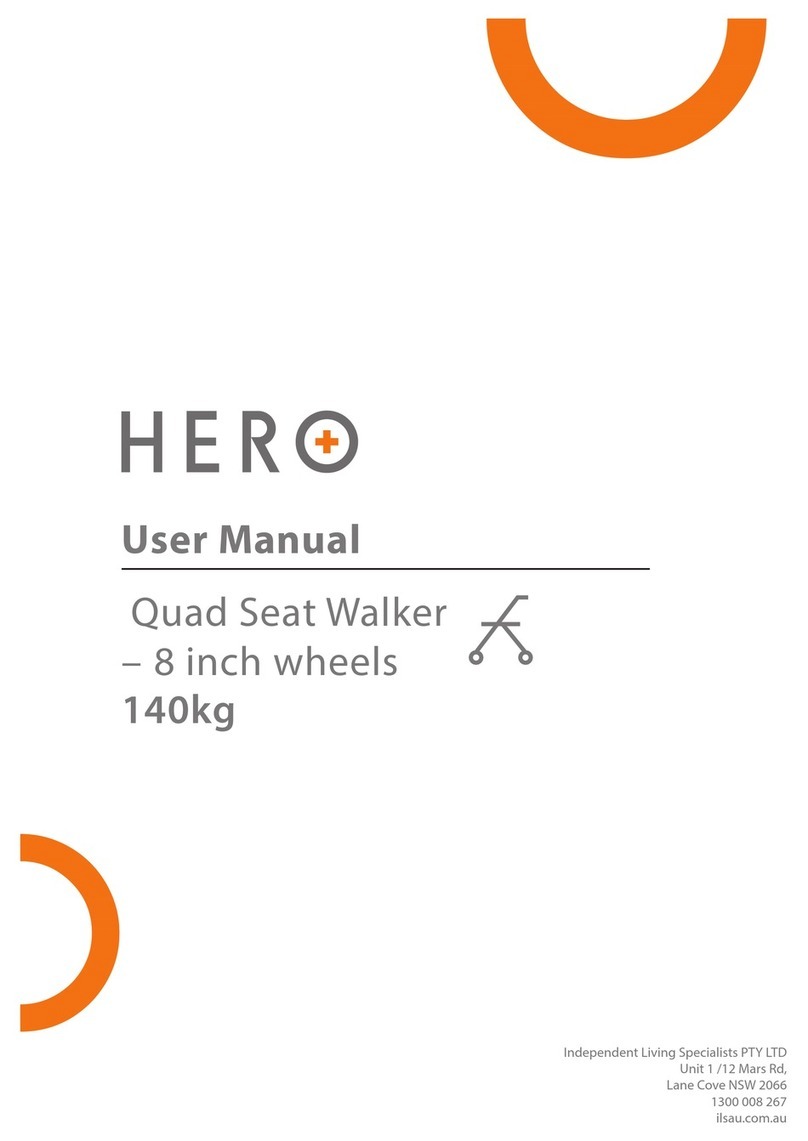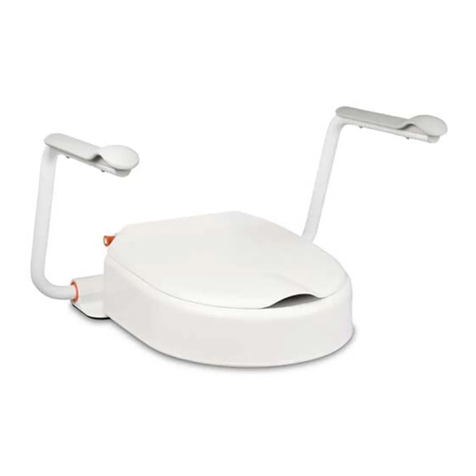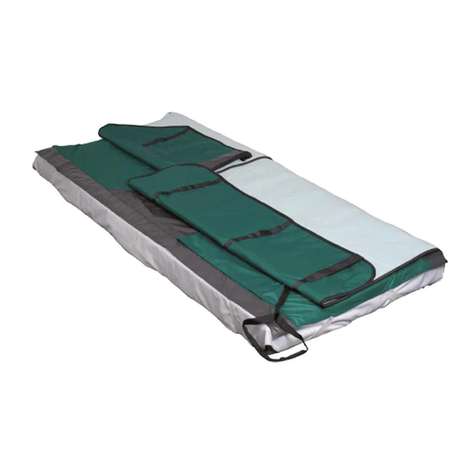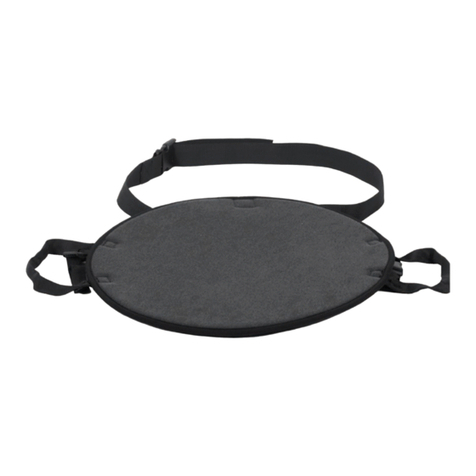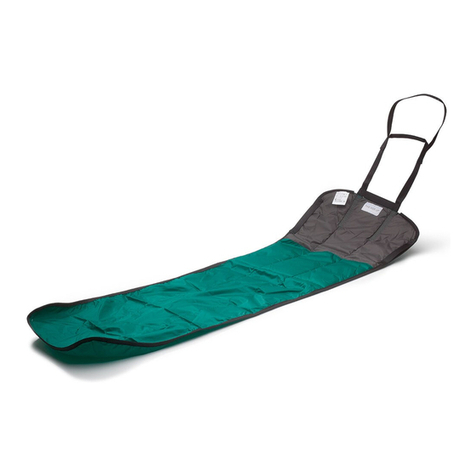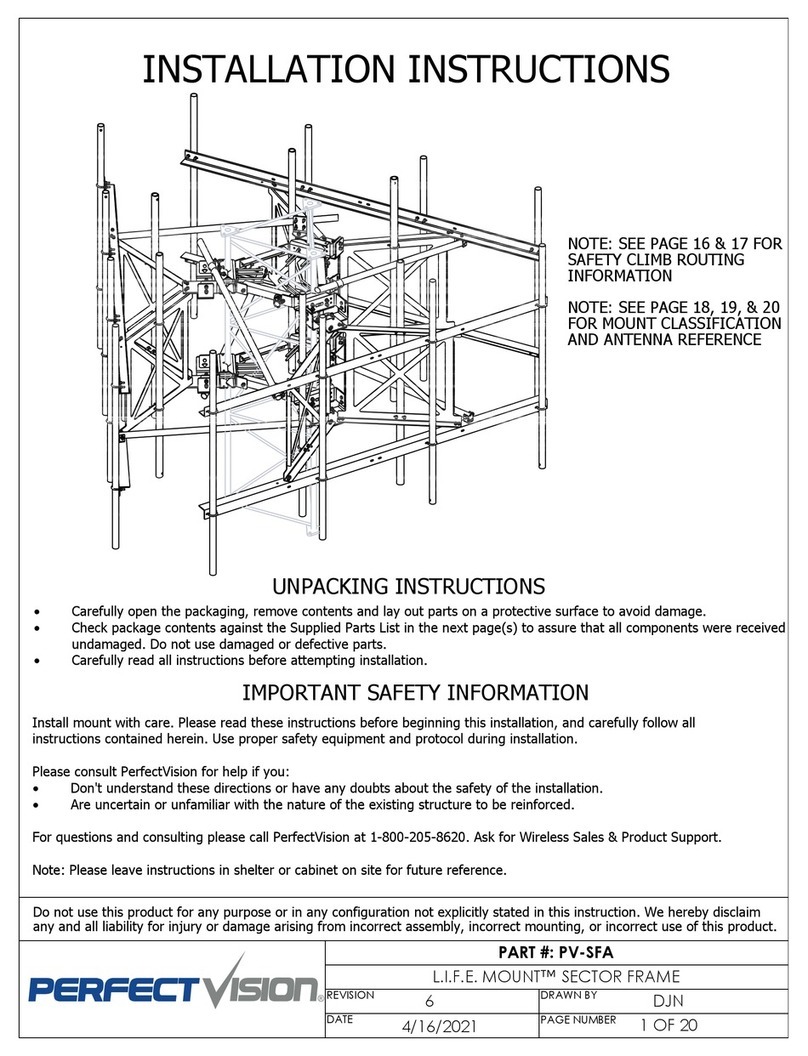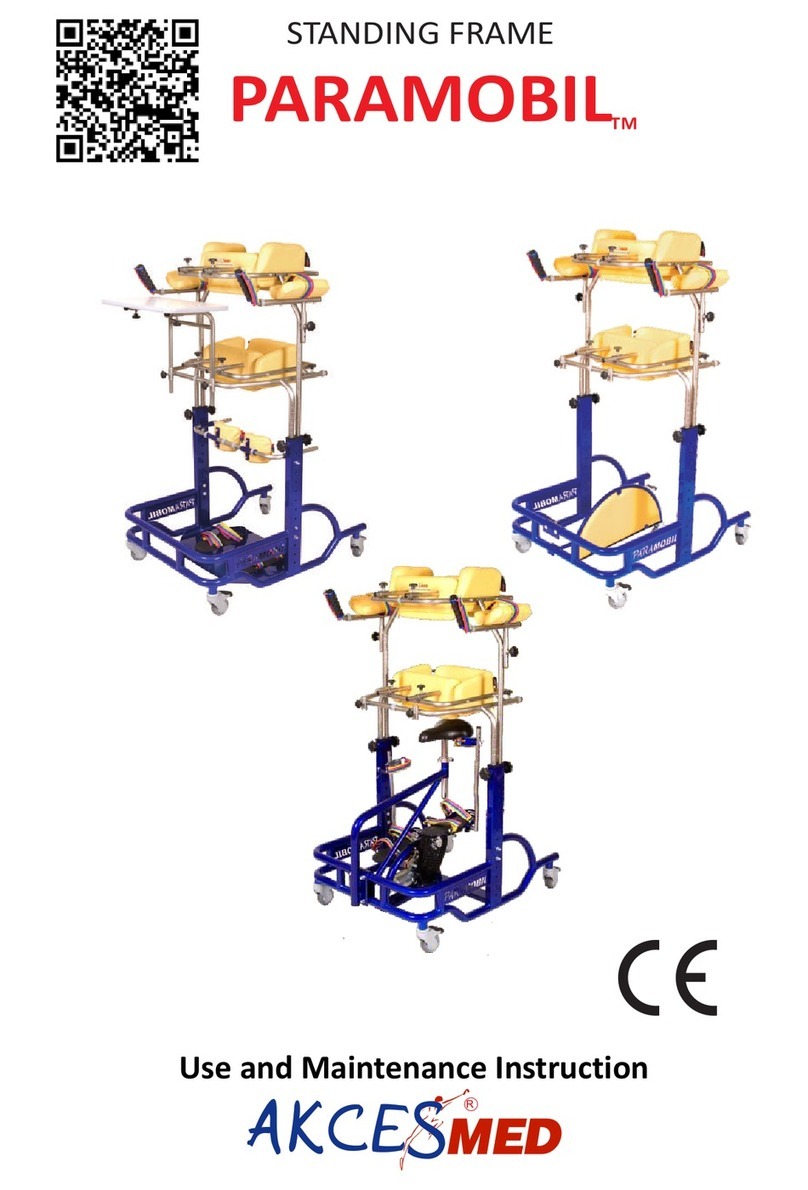Ormesa BUG Manual

USE AND MAINTENANCE HANDBOOK
modular seating system
ISO 7176/19
ANSI RESNA WC/19
HI-LOW FEEDING BASE
856
HI-LOW COMPACT BASE
851 with
INDOOR BASES
FOUR-WHEEL BASE
869
with
OUTDOOR BASE
SEAT UNIT
INGLESE - Cod. 22919 17-01-23


1/101
Thank you for choosing Bug, from ORMESA s.r.l.
BUG is a medical device designed and manufactured by ORMESA srl. ISO 13485 certified Italian
company.
We recommends that you read this manual very carefully to fully understand its
contents. In addition to help you become familiar with BUG quickly, it also contains
practical tips for making the best use of it safely and keeping it in good working order.
If, after reading it, you still have questions, contact your retailer, who will be happy to help you, or call
ORMESA directly at +39 0742 22927, send a fax to +39 0742 22637 or send an e-mail to:
Ormesa Team

2/101
TABLE OF CONTENTS
WARNINGS ............................................................................................................. 4
GUARANTEE .......................................................................................................... 9
HOW TO STORE AND TRANSPORT THE MEDICAL DEVICE ............................. 9
WHAT NOT TO DO WITH THE PRODUCT ............................................................ 10
HOW TO TILT THE BUG AND CLIMB UP PAVEMENTS ...................................... 11
HOW TO USE THE BUG 4-WHEEL STROLLER WITH 869 BASE FOR TRANSPORT
ON A MOVING VEHICLE (private cars, buses, etc.) ............................................ 12
LABELS AND PLATES ........................................................................................... 17
WHAT Bug IS .......................................................................................................... 18
TECHNICAL FEATURES ........................................................................................ 18
BASE 869 BRAKING .............................................................................................. 19
BASE 856 BRAKING .............................................................................................. 19
INITIAL PREPARATION ......................................................................................... 20
PACKAGING INFORMATION ........................................................................................ 20
HOW and WHERE TO HOLD the COMPONENTS of BUG, in SAFETY ....................... 20
Bug SEAT UNIT ...................................................................................................... 21
SEATING UNIT ADJUSTMENTS ............................................................................ 22
ADJUSTING THE INCLINATION OF THE SEAT (TILT-IN-SPACE SYSTEM) .............. 22
RECLINING THE BACKREST ....................................................................................... 23
ADJUSTING THE HEIGHT OF THE BACKREST .......................................................... 24
ADJUSTING THE WIDTH OF THE SEAT BASE ........................................................... 25
ADJUSTING THE LEGREST ......................................................................................... 26
ADJUSTING THE FOOTREST ...................................................................................... 27
ADJUSTING THE DEPTH OF THE SEAT ..................................................................... 28
Bug seat with 4-WHEEL base 869 ....................................................................... 29
TECHNICAL SPECIFICATIONS of Bug with four wheel BASE 869 ................... 30
HOW TO USE Bug WITH BASE 869 ...................................................................... 32
OPENING the STROLLER ........................................................................................... 32
HOW TO ATTACH THE SEAT TO THE FRAME ........................................................... 33
HOW TO REVERSE THE SEAT SO THAT THE CHILD FACES HIS MOTHER(FIG.A)
........................................................................................................................................ 34
HOW TO DETACH THE SEAT FROM THE FRAME ..................................................... 35
FOLDING THE BASE ................................................................................................... 36
ADJUSTING THE INCLINATION OF THE HANDLE ..................................................... 37
FRONT WHEEL DIRECTION LOCKS ........................................................................... 37
Bug seat with INDOOR base 856 ......................................................................... 38
TECHNICAL SPECIFICATIONS of Bug with BASE 856 ..................................... 39
HOW TO USE Bug WITH BASE 856 ..................................................................... 40
HOW TO ATTACH THE SEAT TO THE FRAME ........................................................... 40
HOW TO DETACH THE SEAT FROM THE FRAME ..................................................... 41
ADJUSTING THE HEIGHT OF THE SEAT .................................................................... 42
Bug seat with INDOOR base 851 ............ ............................................................. 44

3/101
TECHNICAL SPECIFICATIONS of Bug with BASE 851 ....................................... 45
HOW TO USE Bug with BASE 851 ............. .......................................................... 46
HOW TO ATTACH THE SEAT TO THE FRAME ........................................................... 46
HOW TO DETACH THE SEAT FROM THE FRAME ..................................................... 47
ADJUSTING THE HEIGHT OF THE SEAT with BASE 851 ........................................... 48
BASE 851 BRAKING ...................................................................................................... 49
MOUNTING THE ADDITIONAL COMPONENTS .................................................... 50
HEADREST with OCCIPITAL-PARIETAL PROTECTIONS 863 .................................... 50
ERGONOMIC HEADREST 942 ..................................................................................... 54
HEADREST with PARIETAL PROTECTIONS 852 ........................................................ 57
THERMIC COVER 818 .................................................................................................. 59
CANOPY 819 ................................................................................................................. 60
RAIN COVER 825 .......................................................................................................... 61
FOOT STRAPS 827 ....................................................................................................... 62
Padded ABDUCTION BLOCK 834 ................................................................................. 62
ADJUSTABLE ABDUCTION BLOCK 834R ................................................................... 63
FRONT HANDLE 839 .................................................................................................... 66
FLEXIBLE AND WRAP-AROUND SIDE SUPPORTS FOR THE TRUNK 868 .............. 67
891 TIEDOWN HOOKS (4 RINGS) 891 ......................................................................... 68
VEST HARNESS 853 ..................................................................................................... 68
NET BASKET 858 .......................................................................................................... 69
45° SEAT BELT 894 ...................................................................................................... 69
Padded SIDE SUPPORTS 838 ...................................................................................... 70
TRAY 824 ....................................................................................................................... 71
TRAY for BUG WITH 856 and 851 BASES 824B .......................................................... 72
5-POINT VEST HARNESS 903 ..................................................................................... 75
5-POINT HARNESS 906 ................................................................................................ 76
PADDED COVERING for FOOTPLATE 892 .................................................................. 78
HAND BRAKE 905 ......................................................................................................... 79
VENT TRAY 911 ............................................................................................................ 84
OXYGEN BOTTLE HOLDER 935 .................................................................................. 86
BOTTLE HOLDER 922 .................................................................................................. 88
4-POINT SEAT BELT 920 .............................................................................................. 89
SIBLING REAR FOOTBOARD 921 ............................................................................... 91
ATTACHING THE CUSHION ................................................................................... 94
MAINTENANCE ....................................................................................................... 96
1. ORDINARY MAINTENANCE (monthly) .................................................... 96
2. PREVENTIVE MAINTENANCE (biennial) ................................................ 96
3. EXTRAORDINARY MAINTENANCE (or corrective) ............................. 97
CLEANING, DISINFECTION, SANITIZATION ........................................................ 98
INFORMATION .............................................................................................................. 98
WARNINGS .................................................................................................................... 98
PROCEDURE ................................................................................................................ 99
CUSTOMER SERVICE AND SPARE PARTS ......................................................... 100
CONDITIONS FOR DURABILITY, REUSE AND REASSIGNMENT TO A NEW USER
.................................................................................................................................. 101

4/101
WARNINGS
-CAREFULLY READ AND UNDERSTAND THE INSTRUCTIONS IN THIS MANUAL
BEFORE USING THE DEVICE BECAUSE THEY HAVE BEEN WRITTEN WITH
THE USER'S SAFETY IN MINDand they will help the carer use the product safely and
keep it in good working order. The Use and Maintenance Manual is an integral part
of the product and must be carefully preserved for future reference.
-The manual is intended for technically qualified retailers and users and their
assistants; it provides instructions for its correct use and must be supplemented by
adequate knowledge of the rehabilitation program for which it has been prescribed.
-The manual reflects the technical state of the product at the time it was sold. ORMESA
s.r.l. reserves the right to make any changes to the product ormanual suggested
by experience, technical considerations or regulatory developments without any
obligation to update its previous production and relevant manual.
-The use of the device and its accessories must be checked by a specialized
doctor,in conformity with the laws and standards in force.
-The Bug is intended for use by people whose size and weight fall within the range
of the "Technical Specifications" on pages 30-31, 39, 45, and was exclusively
designed for the transport and placement of children.
-Bug is available in two sizes: change to a larger device as the child grows
-Bases 869 and 901 were designed for outdoor use. Bases 856, 851 are only
intended for indoor use.
-The 812 direction locks on the front wheels of outdoor bases were exclusively
designed to use the aid on rough terrain: in all other cases, they must be disengaged
to avoid difficulty in manoeuvring the device
-The aid Bug with 869 and 901 bases, must be manoeuvred by people with the
height and strength to control its movements
-Before each use always check that brakes are working, the wheels are not
excessively wornand that the frame, backrest and footrest are locked
- Make sure that all adjustable parts are locked before each use
- When parking, always apply both brakes, even on level ground
- Always lock the brakes before making any type of adjustment
-The PADDED UPHOLSTERY IS FIRE-RETARDANT: it conforms to class 1 IM of the
Italian UNI 9177 standard. KEEP however ALL THE ACCESSORIES AWAY FROM
SOURCES OF IGNITION because THEY ARE NOT FIRE-RESISTANT
-THE FIRE RETARDANT PROPERTIES ARE INHERENT TO THE YARN AND THEY
DO NOT COME FROM ADDITIONAL TREATMENTS

5/101
USING THE SEAT UNIT WITHOUT THE USER
THE BUG SEAT UNIT can be POSITIONED on EVERY FLAT SURFACE
see fig.b (table) and fig. c (floor)provided that the following INDICATIONS are
followed:
Place the leg rest in extension or tilt it completely before placing the seat
unit on the floor (Fic. c)
HOW TO TAKE THE SEAT UNIT
SEAT UNIT
POSITIONED ON A TABLE
SEAT UNIT
POSITIONED ON THE FLOOR

6/101
IF THE SEAT TILTS,
IT IS NOT ATTACHED
IF THE SEAT REMAINS ATTACHED
USING THE SEAT UNIT WITH THE USER POSITIONED
FIX THE SEAT TO THE FRAME
According to the instructions given on page 33 for 869 base, on page 40 for 856
base, on page 46 for 851 base
ATTENTION!
BEFORE POSITIONING THE CHILD, MAKE SURE THAT
THE SEAT UNIT IS ATTACHED TO THE FRAME
OK
NO

7/101
THE SEAT UNIT CAN ALSO BE USED SEPARATELY FROM THE FRAME
(869 AND 856, 851 BASES) FOR VERY SHORT PERIODS AND UNDER
THE CAREFUL CONTROL OF AN ADULT.
IN SUCH CASES MAKE SURE THAT THE WHOLE SUPPORT SURFACE
OF THE SEAT UNIT IS IN CONTACT WITH THE TABLE OR THE FLOOR
(see fig. d, e).
Support surface
Support surface
Support surface
Support surface
NEVER POSITION THE SEAT UNIT IF THE BASE IS NOT
PERFECTLY ADHERENT TO THE SUPPORT SURFACE (see fig. f).
Support surface
Support surface
fig. d
fig. e
fig. f

8/101
BUG IS A MECHANICAL MEDICAL DEVICE:
THE USER has to perform REGULAR MAINTENANCE and
CLEANING following the instructions shown in the "Maintenance" chapter
on page 96-97-98-99-100 and HAVE THE DEVICE INSPECTED AT THE
INTERVALS INDICATED to VERIFY that it is WORKING PROPERLY and in
GOOD CONDITION, otherwise warranty will fail and marking will
lapse
PRODUCT REPAIRS other than the regular maintenance shown on page
96-97-98-99-100 of the manual must be ONLY MADE by a
SPECIALIZED SERVICE CENTER in the maintenance of mechanical
aids for disables, otherwise warranty and marking will be voided
Any CHANGES in the product ARE NOT AUTHORIZED. REFER ONLY
TO ORMESA, otherwise warranty and marking will be voided
The REPLACEMENT WITHOUT ORIGINAL PARTS OR
COMPONENTSARE NOT AUTHORIZED. REFER ONLY TO ORMESA,
otherwise warranty and marking will be voided
In case of DOUBT about the SAFETY of the product or DAMAGE to
parts or components, you are urged to IMMEDIATELY DISCONTINUE
USE and CONTACT a SPECIALIZED SERVICE CENTER in the
maintenance of mechanical aids for disables, or directly ORMESA.
THE BUG 4-WHEEL STROLLER (seat unit + 869 base) conforms to
the ISO 7176-19 and ANSI RESNA WC/19 standard, which defines
the SAFETY REQUIREMENTS FOR TRANSPORT, facing in the
direction of travel, on MOVING VEHICLES (private cars, buses, etc.)
FOR THE ASSEMBLY OF THE 891 ACCESSORY AND
ANCHORING THE STROLLER TO THE VEHICLE, CAREFULLY
READ THE INSTRUCTIONS AND NOTICES ON PAGES 14, 15, 16
and 17 OF THIS MANUAL

9/101
GUARANTEE
ORMESA warrants the product for 2 years; in case of problems, contact the retailer
where you purchased it.Always ask for original spare parts, otherwise the guarantee
will decline
ORMESA will not be liable for damage in the following cases:
-use by an unsuitable person;
-incorrect assembly of parts or accessories;
-unauthorized modifications or service;
-use of other than original replacement parts and parts subject to wear (upholstery,
wheels, etc);
-improper use (such as, transporting objects or loads larger or heavier than those ones
shown in the instruction manual);
-damage caused by incorrect use and lack of regular maintenance, as shown in the
instruction manual;
-exceptional events;
-failure to follow the instructions in this manual.
THE GUARANTEE DOES NOT COVER WEAR PARTS, which are subject to wear
and tear, such as the upholsteries and the wheels.
HO
HOW TO STORE AND TRANSPORT THE MEDICAL DEVICE
TO AND TRANSPORT THE MEDICAL DEVICE
THE DEVICE MUST BE STORED AND PACKED using the Ormesa original
packaging materials, unless the guarantee will be voided
-Once unpacked, THE TRANSPORT OF THE DEVICE must be done by
ANCHORING it ADEQUATELY to the vehicle
-When travelling by plane, or in the car, DO NOT SUBJECT THE FOLDED FRAME
TO LOADS THAT, especially with road bumps, COULD DAMAGE ITS
STRUCTURE
THE DEVICE MUST BE PARKED / STORED IN CLOSED AND DRY PLACES
-THE OPERATING ENVIRONMENT HAS NO PARTICULAR INFLUENCE ON THE
DEVICE UNLESS IT IS USED INCORRECTLY, such as by leaving it parked for
a long time in direct sunlight or exposed to bad weather such as rain, or in
MARINE ENVIRONMENTS, where the salt air could corrode the paint and
sliding parts. IN THIS CASE, WE RECOMMEND CAREFULLY CLEANING AND
DRYING THE FRAME FOLLOWING THE INSTRUCTIONS SHOWN IN THE
“MAINTENANCE, CLEANING AND DISINFECTION” CHAPTER ON PAGES 96-
97-98-99-100 AND THE WARNINGS ON PAGE 96

10/101
WHAT NOT TO DO WITH THE PRODUCT
-DO NOT CARRY THE CHILD OVER ROUGH OR STEEP SURFACES OR STAIRS
-DO NOT ALLOW CHILDREN TO USE THE PRODUCT, NOT EVEN FOR PLAYING
-DO NOT PLACE HOT CONTAINERS OR OBJECTS ON THE TRAY SURFACE
BECAUSE THEY COULD TIP OVER AND BECAUSE THE COVERING COULD BE
SEVERELY DAMAGED
-DO NOT ATTACH WEIGHTS TO THE PUSH HANDLE Of THE PUSHCHAIR SO AS
NOT TO PUT AT RISK ITS STABILITY DURING USE
-NEVER LEAVE THE CHILD ALONE IN THE DEVICE
-NEVER LEAVE THE PRODUCT PARKED ON A SLOPING SURFACE
- DO NOT USE THE ALTERNATIVE PNEUMATIC WHEELS (BASE 869 FOR
OUTDOOR USE) WITH FLAT TYRES, TO AVOID THE RISK OF TIPPING FROM LOSS
OF STABILITY - TYRE PRESSURE 2.5 Atm, see the "MAINTENANCE" chapter on
page 96
-DO NOT LET ANYONE CLIMB ONTO THE FOOTREST OR RIDE ON THE BACK OF
THE OUTDOOR BASE
-DO NOT LIFT THE PRODUCT BY THE LEG SUPPORT FRAME ORFOOTREST (i.e.
TO CLIMB OVER OBSTACLE)
-DO NOT USE THE PRODUCT TO CLIMB OR DESCEND STAIRS: ITS STRUCTURE
WAS NOT DESIGNED FOR THIS PURPOSE
-NEVER LEAVE THE STROLLER PARKED FOR A LONG TIME IN DIRECT SUNLIGHT
OR NEAR SOURCES OF HEAT: THIS WILL AVOID OVERHEATING THE DEVICE AND
DISCOLOURING THE UPHOLSTERY
-DO NOT CLIMB PAVEMENTS OR STEPS WITH JUST THE STROLLER’S SIDE
WHEELS (FRONT AND BACK) OF THE 869 BASE (SEE FIG. ON PAGE 11), BECAUSE
THEY COULD TIP OVER
-When the SEAT is COMPLETELY TILTED BACKWARDS and the BACK is
COMPLETELY RECLINED, DO NOT CLIMB OVER OBSTACLES OR STEEP SLOPES
that, SINCE THEY COULD EXCEED 12°, COULD CAUSE THE STROLLER TO TIP
OVER (SEE FIG. PAGES 11)
-DO NOT USE THE PRODUCT IF PARTS ARE MISSING OR DAMAGED.INSIST THAT
ONLY ORIGINAL REPLACEMENT PARTS ARE USED BECAUSE ANY OTHER TYPE
WILL VOIDTHE WARRANTY AND CE MARKING
-The Seat Unit Bug without 869 four wheels base has not been homologated ECE/44
or AS/NZS 1754 to be used as car seat. Bug+869 has been homologated for use
according to ISO 7176/10 or ANSI RESNA WC/19 (see pag. 12-16)

11/101
HOW TO TILT THE BUG AND CLIMB UP PAVEMENTS
BUG WITH 4-WHEEL BASE 869
ATTENTION!
ADJUST THE HANDLE (see page 38) TO THE CORRECT HEIGHT FOR THE
ATTENDANT to avoid excessive effort when climbing stairs and facilitate manoeuvres
CLIMB
FACING FORWARD
DESCEND
FACING BACKWARD
ADJUSTABLE HANDLEBAR

12/101
HOW TO USE THE BUG 4-WHEEL STROLLER WITH 869
BASE FOR TRANSPORT ON A MOVING VEHICLE (private
cars, buses, etc.)
THE BUG 4-WHEEL STROLLER (seat unit + 869 base) conforms to the ISO 7176-19 and ANSI
RESNA WC/19 standard, which defines the safety requirements for transport, facing in the
direction of travel, on moving vehicles (private cars, buses, etc.).
In order to use it safely, carefully read the warnings and follow the instructions given on
pages from 14 to 17.
-THE PUSHCHAIR-SEATED OCCUPANT MUST FACE THE FRONT OF THE VEHICLE (see fig.
4, page 17). According to the ISO 7176-19 point 6.3.4, compliance with ISO 7176-19 does not
preclude using the pushchair facing rearward in large accessible vehicles equipped and approved
with rear-facing wheelchair passenger stations
-The child should weigh at least 22 kg (48.5 lbs) because the CRASH TEST provided by the
ISO and ANSI/RESNA standards only refers to wheelchairs/pushchairs for users whose weight
is 22 kilos or more
-THE VEHICLE MUST BE APPROVED FOR TRANSPORTING ORTHOPAEDIC
WHEELCHAIRS/STROLLERS IN CONFORMITY WITH STANDARD ISO 7176-19 (see fig. 4,
page 16)
-THE CHILD MUST WEAR BOTH A LAP BELT AND A DIAGONAL SHOULDER BELT ISO
7176-19- OR ISO 10542-APPROVED (i.e., belts with a label of conformity to these ISO
standards). THE USE OF A LAP BELT BY ITSELF IS NOT RECOMMENDED. Postural belts,
such as models 828, 853, 894, 903 and 906 are not type-approved for use as restraint
systems and can only be used in addition
-THE STROLLER MUST BE ANCHORED TO THE MOTOR VEHICLE WITH THE BACKREST
AND THE LEGREST IN THE UPRIGHT POSITION by: 1) a four-point strap-type tie down
system that complies with ISO 10542-2, supplied by the vehicle and 2) our accessory 891
-set of 4 tie-down hooks (see fig. 1 and 2, page 14; fig. 3, page 15 and fig. 4, page 16)
!ATTENTION!
ORMESA RECOMMENDS THE USE OF A COMPLETE ISO 10542-2-COMPLIANT
“WTORS” SYSTEM, which consists of restraint systems for both the wheelchair and its
occupant
-whenever the child is transferred on a seat of the vehicle, the unoccupied pushchair
should be stored in a cargo area or secured in the vehicle during travel
-in order to preserve their effectiveness, belt restraints should not be held away from the body
by wheelchair components or parts, such as the wheelchair armrests or wheels (see fig 5 and
6, page17)
-shoulder-belt restraintsshould fit over the shoulders (see fig. 5, page 17)
-belt restraints should be adjusted as tightly as possible, consistent with user comfort, and
belt webbing should not be twisted when in use
- in order to reduce the potential of injury to vehicle occupants, during the transport the tray and
all accessories should be removed and secured separately in the vehicle
THE STROLLER MUST BE INSPECTED BY THE MANUFACTURER OR ITS AUTHORIZED
RETAILER OR DISTRIBUTOR BEFORE REUSE FOLLOWING INVOLVEMENT IN ANY TYPE
OF VEHICLE COLLISION
ANY ALTERATION OR SUBSTITUTION OF THE 891 TIEDOWN HOOKS OR STROLLER
PARTS OR COMPONENTS, WITHOUT THE WRITTEN AUTHORIZATION OF ORMESA
SRL, IS FORBIDDEN AND WILL VOID THE MARK AND THE WARRANTY

13/101
1) POSITION THE 891 TIEDOWN HOOKS (4 RINGS) ON THE POINTS
(NOTCHES) INDICATED ON THE FRAME (only for the 4-wheel 869
base) AND FIX THEM FOLLOWING THE INSTRUCTIONS ON PAGE 15
VIEW FROM THE FRONT
VIEW FROM BEHIND
891 SECUREMENT POINTS
FIXING HOLE
Fig. 1
Fig. 2
891 SECUREMENT POINTS
FIXING HOLE

14/101
2) HOW TO FIX THE 891 TIEDOWN (4 RINGS) ON THE FRAME (only for 4-
wheel 869 base)
ATTENTION:
-suitable for ISO 10542-approved four-point
straps provided in the vehicle. To anchor the
stroller to the transport vehicle, see the
instructions on page 16
-the child must wear both a lap belt and a
diagonal shoulder belt ISO 7176-19- or ISO
10542-approved (i.e., belts with a label of
conformity to these ISO standards).
Postural belts, such as models 828, 853, 894,
903 and 906 are not approved for use as
restraint systems and can be only used in
addition
-the vehicle must be suitable for
transporting orthopaedic strollers in
conformity with current law
-read the notices and instructions provided
on page 9 of this use and maintenance
manual. The 891 tiedown hooks are safety
devices and, as such, they must be fixed to
the 869 frame by skilled personnel, such as
the manufacturer or reseller that supplied the
stroller
ISO 7176-19 a
A
n
S
d
H
AN
TESTE
SI RESN
D
A WC/19
CR
Fig. 3
BUSHING
SCREW M8X55
HEX
WRENCH
WRENCH
NUT M8
NUT M8
PLASTIC
VIEW FROM BEHIND
SCREW
WRENCH
HEX
WRENCH
NUT M8
M8X40

15/101
3) HOW THE STROLLERIS TO BE SECURED IN A VEHICLE
4-POINT STRAP-TYPE TIEDOWN
PUSHCHAIR RESTRAINT
HOOK THE APPROVED 4-POINT BELTS OF THE VEHICLE TO THE 891-4 TIEDOWN HOOKS
(4 RINGS) AS SHOWN IN THE FIGURE AND IN THE DIRECTION OF TRAVEL OF THE
VEHICLE
Fig. 4
types of tiedown end-fittings
that are compatible with our accessory
891 – set of 4 tiedown hooks
Direction of travel
of the vehicle
Vehicle's ISO 10542-2
belts and hooks
891 TIEDOWN HOOKS
891 TIEDOWN HOOKS

16/101
4) THE CORRECT POSITIONING OF OCCUPANT BELT RESTRAINTS ON
THE USER
ATTENTION! the pelvic-belt restraint should be worn low across the front of the pelvis, so that
the angle of the pelvic-belt restraint is within the preferred zone of 30° to 75° to the horizontal,
similar to that shown in Figure 5. A steeper (greater) angle within the preferred zone is
desirable,
ATTENTION! Our belts, straps, vests and harnesses are not intended to be as an occupant
restraint in a moving, but they can be used in addition
YES
beneath
the armrest
and the
frame
FRONT VIEW SIDE VIEW Fig. 5
NO
above
the armrest
and the
frame
THE INCORRECT PLACEMENT OF BELT RESTRAINTS
Fig. 6

17/101
READ AND UNDERST AND THE USE AND
MAINTENANCE INSTRUCTIONS
LIRE ET COMPRENDRE LES INSTRUCTIONS POUR
L’UTILISATION ET L’ENTRETIEN
!BITTE LESEN SIE DIE GEBRAUCHSANWEISUNG
SORGFÄLTIG DURCH UND BEACHTEN SIE DIE ENTSPRECHENDEN HINWEISE
LEER Y COMPRENDER LAS INSTRUCCIONES DE USO
Y MANTENIMIENTO
Name of the model Series number Catalog code
Date of Medical
deviceproduction
LOT code Warning! Read the use and
maintenance handbook before use
Max. load
Conformity with the European
safety standards
!
M
M
Via delle Industrie, 6/8 - Z.I. Sant’Eraclio 06034 Foligno (PG) ITALY Tel. +39 0742 22927 Fax + 39 0742 22637
SECUREMENT POINT FOR THE ANCHORAGE OF THE ISO 10542-2
APPROVED 4-POINT STRAP-TYPE TIEDOWN SUPPLIED BY THOSE
VEHICLE WICH ARE SUITABLE FOR TRANSPORTING ORTHOPEDIC
PUSHCHAIR IN COMPLIANCE WITH THE ISO 7176-19 STANDARD
SBLOCCA
UNLOCK
BLOCCA
LOCK
NO
IF THE SEAT TILT, IT IS
NOT ATTACHED
IF THE SEAT REMAINS ATTACHED
OK
PRIMA DELL’USO, VERIFICA
DI AVERE AGGANCIATO IL
SEGGIOLINO!
BEFORE USE, MAKE SURE
YOU HAVE ATTACHED THE
SEAT!
PUSH
TO UNLOCK

18/101
WHAT Bug IS
BUG is a postural seating unit for children with disabilities who need special supports,
supports and adjustments (such as in case of infantile cerebral palsy, degenerative diseases,
generative disorders, bone deformities) easily adaptable thanks to its modularity.
The use of BUG and its components always requires the prescription of a physician that verifies
also its use.
BUG follows the child's growth thanks to its wide range of adjustments and it has a tilt and recline
system included in the seat(and not in the frame), that allows you to maintain the same
posture with the 3 different bases:
-869 Outdoor 4-wheel base;
-901 Outdoor 3-wheel base
-856 High-low adjustable base 856.
The device must be prescribed by a specialized physician, configured and adjusted by a
healthcare professional authorized by the NNS.
TECHNICAL FEATURES
-FRAME foldable, lightweight (aluminium), with a narrow base, easy to push and maneuver
(compact, its wheels do not protrude from the 4-wheel-base). Sturdy and durable, has passed all
stability/fatigue and safety tests, required by the international laws,in specialized
-BACKREST rigid, retentive and able to recline of 40°. Its hinge coincides with the user's hip
physiological fulcrum, so as to avoid that, during the adjustment, the reclining movement causes
the user sliding forward. Height-adjustable by 10 cm size Small and 15 cm size Medium. With
slots for inserting the accessories.
-HEADREST incorporated into the backrest, so that the child’s head is always supported during
the tilt adjustments of the seat and of the backrest, even without accessories.
-SEAT width and depth adjustable by 10 cm in each direction. Reversible size Small
-TILT-IN-SPACE SYSTEM INCORPORATED IN THE SEAT so that, after removing or transfering
the seat, it is not needed to reposition the posture. SAFE because adjustments can be easily
operated by the carer with one only hand, without effort. COMFORTABLE because the tilting
movement is continuous, without jerks. Size Small can be tilted from 0° to 35°; size Medium from
7° to 30°.
-LEGREST adjustable in height and tilt. The hinge coincides with the child’s knee physiological
fulcrum, so as to avoid that the legrest movement may cause any sliding or change of posture of
the child.
-FOOTREST tip-up and flexion-extension adjustable.
-CUSHION padded, ergonomic, removable and attachable to the seat with press studs.
- Fireproof fabric: the fire retardant properties are inherent in the yarn and they do not come
from additional treatments, made after the weaving.
- Recyclable fabric: production cycle with low environmental impact.
- Maximum resistance to rubbing
- Oeko-Tex Certificate: for all fabrics that are in direct contact with the skin, to guarantee quality
and safety for health.
-Durable and highly resistant colours to sweat, light and dry cleaning and washing machine.
-puncture proof WHEELS. Outdoor base 869: front 17 cm; back 25 cm size Small, 30 cm size
Medium. Outdoor base 869: front 17 cm, back 30 cm. With independent drum brakes, directional
locks and shock absorbers; light and easy to push on every surface.
-Feeding base for indoor use 869, adjustable in height: 10 cm swivelling, with brakes.
-Feeding base for indoor use 851, adjustable in height: 7,5 cm swivelling, with brakes.
-4 SIZES in 2: the seat unit grows with a child.
Other manuals for BUG
2
This manual suits for next models
3
Table of contents
Other Ormesa Mobility Aid manuals
Popular Mobility Aid manuals by other brands

Activeforever
Activeforever ES2 owner's manual
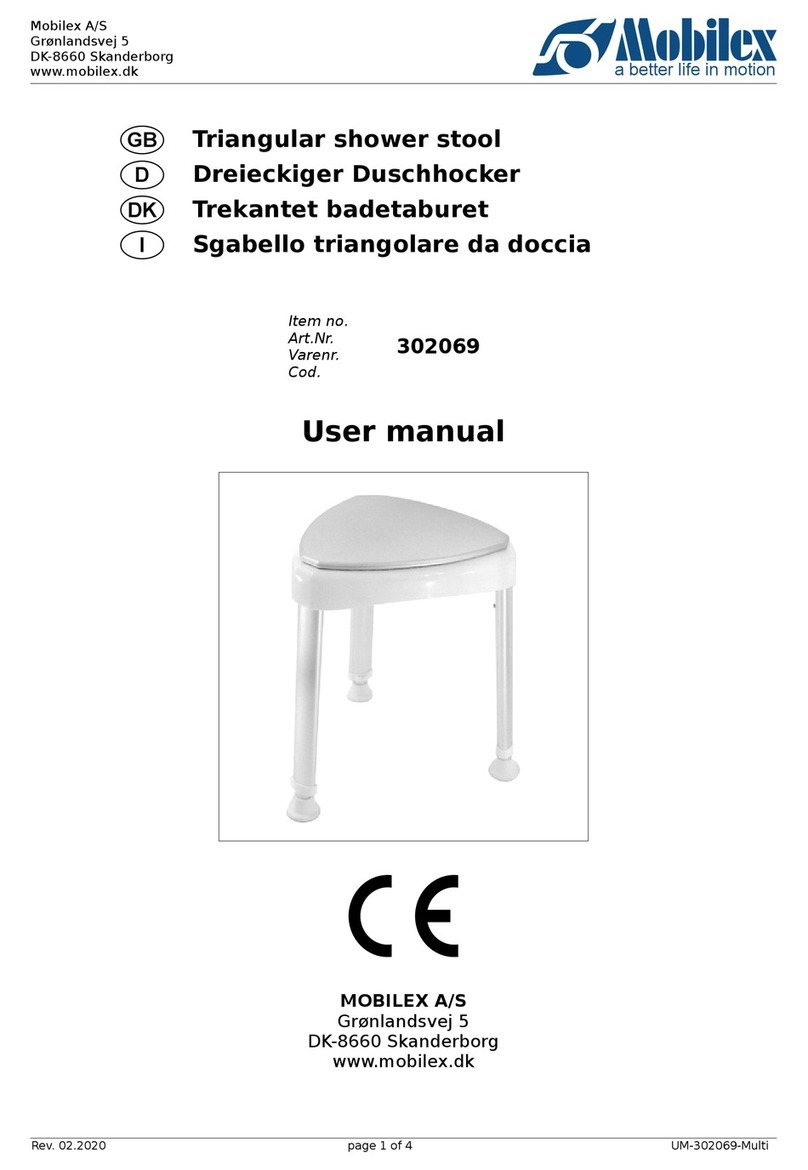
Mobilex
Mobilex 302069 user manual
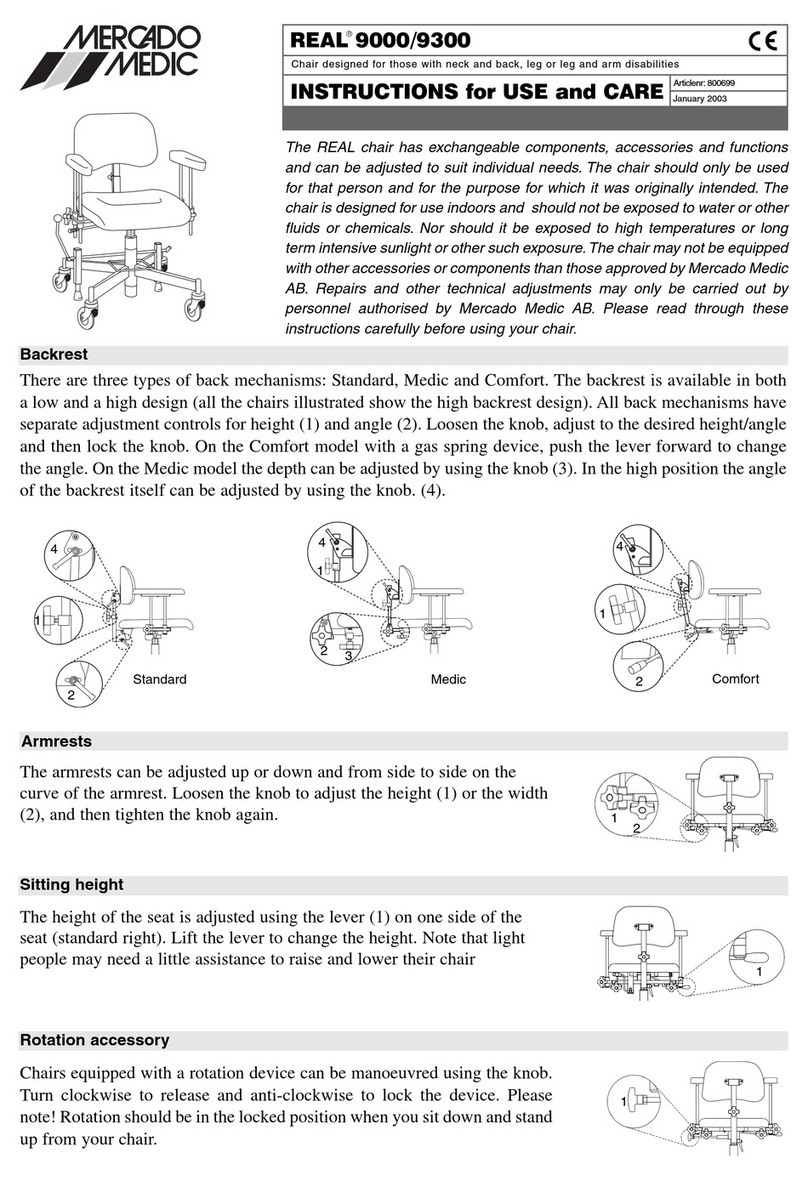
Mercado Medic
Mercado Medic REAL 9000 Instructions for use and care
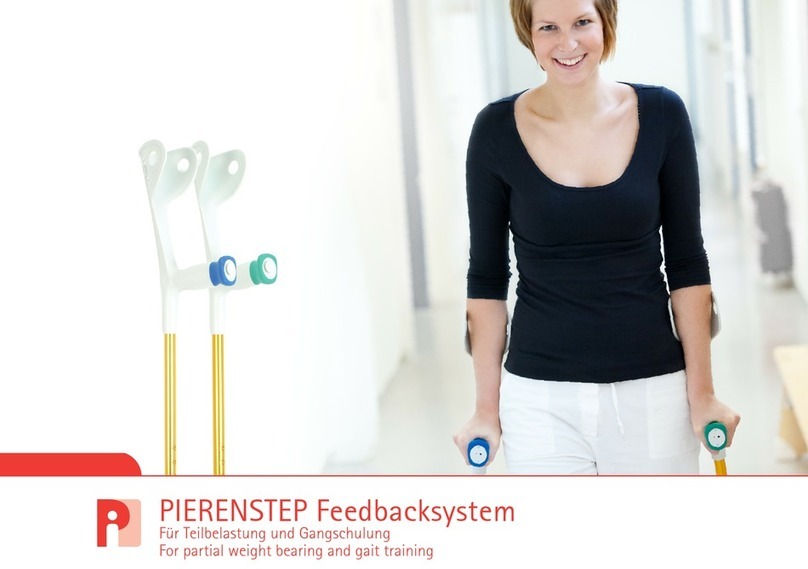
Pierenkemper
Pierenkemper PIERENSTEP operating manual

Invacare
Invacare Aquatec BELUGA user manual
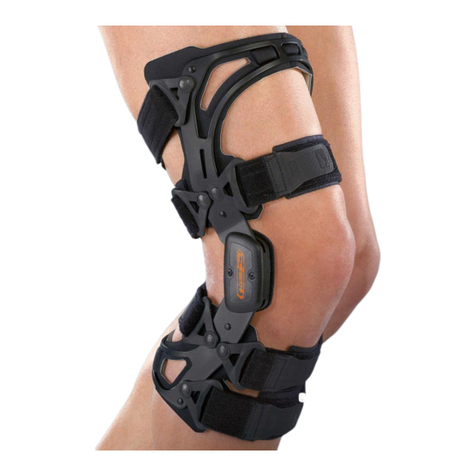
ORTHOSERVICE RO+TEN
ORTHOSERVICE RO+TEN pluspoint 3 Instructions for use
